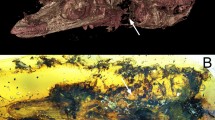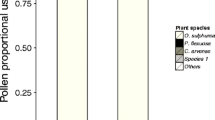Abstract
Aside from pollen and nectar, bees of the subfamily Megachilinae are closely associated with plants as a source of materials for nest construction. Megachilines use resins, masticated leaves, trichomes and other plant materials sometimes along with mud to construct nests in cavities or in soil. Among these, the leafcutter bees (Megachile s.l.) are the most famous for their behaviour to line their brood cells with discs cut from various plants. We report on fossil records of one body fossil of a new non-leafcutting megachiline and of 12 leafcuttings from three European sites—Eckfeld and Messel, both in Germany (Eocene), and Menat, France (Paleocene). The excisions include the currently earliest record of probable Megachile activity and suggest the presence of such bees in the Paleocene European fauna. Comparison with extant leafcuttings permits the interpretation of a minimal number of species that produced these excisions. The wide range of size for the leafcuttings indirectly might suggest at least two species of Megachile for the fauna of Messel in addition to the other megachiline bee described here. The presence of several cuttings on most leaves from Eckfeld implies that the preferential foraging behaviour of extant Megachile arose early in megachiline evolution. These results demonstrate that combined investigation of body and trace fossils complement each other in understanding past biodiversity, the latter permitting the detection of taxa not otherwise directly sampled and inferences on behavioural evolution.


Similar content being viewed by others
References
Altevogt R (1955) Zur Technik der Blattschneidebienen Megachile bicolor F und M. maritima Schck. Beitr Entomol 5:152–165
Berry EW (1931) An insect-cut leaf from the Lower Eocene. Am J Sci 21:301–304
Bischoff H (1927) Biologie der Hymenopteren. Springer Verlag, Berlin
Bohart GE, Youssef NN (1972) Notes on the biology of Megachile (Megachiloides) umatillensis Mitchell (Hymenoptera: Megachilidae) and its parasites. Trans R Ent Soc Lond 124:1–19
Brooks HK (1955) Healed wounds and galls on fossil leaves from the Wilcox deposits (Eocene) of western Tennessee. Psyche 62:1–9
Cockerell TDA (1910) A tertiary leaf-cutting bee. Nature 2102:429
Engel MS (1999) Megachile glaesaria, the first megachilid bee fossil from amber (Hymenoptera: Megachilidae). Am Mus Novitates 3276:1–13
Engel MS (2001) A monograph of the Baltic Amber bees and evolution of the Apoidea (Hymenoptera). Bull Am Mus Nat Hist 259:1–192
Engel MS (2004) Geological history of the bees (Hymenoptera: Apoidea). Rev Tecnologia e Ambiente 10:9–33
Engel MS (2005) Family-group names for bees (Hymenoptera: Apoidea). Am Mus Novitates 3476:1–33
Engel MS (2008) A new species of Ctenoplectrella in Baltic amber (Hymenoptera: Megachilidae). Acta Zool Acad Sci Hung 54:319–324
Engel MS, Perkovsky EE (2006) An Eocene bee in Rovno Amber (Hymenoptera: Megachilidae). Am Mus Novitates 3506:1–12
Friese H (1923) Die europäischen Bienen (Apidae). Walter de Gruyter & Co., Berlin
Grimaldi DA (1996) Amber: window to the past. Abrams, New York
Hasenkamp K-R (1974) Ökophysiologische und ökethologische Untersuchungen an Blattschneidebienen. Forma et Functio 7:139–178
Horne M (1995) Leaf area and toughness: effects on nesting material preferences of Megachile rotundata (Hymenoptera: Megachilidae). Ann Entomol Soc Am 88:868–875
Johnston JE (1993) Insects, spiders, and plants from the Tallahatta Formation (Middle Eocene) in Benton County, Mississippi. Miss Geol 14:71–82
Kim J-Y (1992) Nest dimensions of two leaf-cutter bees (Hymenoptera: Megachilidae). Ann Entomol Soc Am 85:85–90
Kim J-Y (2007) Disc size regulation in the brood cell building behavior of leaf-cutter bee Megachile tsurugensis. Naturwissenschaften 94:981–990
Labandeira CC (2002) Paleobiology of middle Eocene plant-insect associations from the Pacific Northwest: a preliminary report. Rocky Mountain Geology 37:31–59
Lewis SE (1994) Evidence of leaf-cutting bee damage from the Republic sites (Middle Eocene) of Washington. J Paleont 68:172–173
Medler JT (1958) A note on Megachile inermis Prov. in trap-nests in Wisconsin. Can Entomol 90:325–327
Mertz DF, Renne PR (2005) A numerical age for the Messel fossil deposit (UNESCO World Heritage Site) derived from 40Ar/39Ar dating on a basaltic rock fragment. Cour Forschinst Senckenberg 255:67–75
Mertz DF, Swisher CC, Franzen JL, Neuffer FO, Lutz H (2000) Numerical dating of the Eckfeld maar fossil site, Eifel, Germany: a calibration mark for the Eocene time scale. Naturwissenschaften 87:270–274
Meyer HW (2003) The fossils of Florissant. Smithsonian Institution Press, Washington
Michener CD (1953) The biology of a leaf-cutter bee (Megachile brevis) and its associates. Univ Kansas Sci Bull 35:1659–1748
Michener CD (2007) The bees of the world, 2nd edn. Johns Hopkins Univ Press, Baltimore
Nel A, Petrulevicius JF (2003) New Palaeogene bees from Europe and Asia. Alcheringa 27:277–293
Roubik DW (1989) Ecological and natural history of tropical bees. Cambridge University Press, Cambridge
Russel DE (1982) The geology of the Menat basin, France. Palaeontographica (B) 182:89–90
Sarzetti L, Labandeira CC, Genise JF (2008) A leafcutter bee trace fossils from the Middle Eocene of Patagonia Argentina and a review of megachilid (Hymenoptera) ichnology. Palaeontology 51:933–941
Stephen WP, Torchio PF (1961) Biological notes on the leaf-cutter bee Megachile (Eutricharaea) rotundata (Fabricius). Pan-Pac Entomol 37:85–93
Strickler K, Scott VL, Fischer RL (1996) Comparative nesting ecology of two sympatric leafcutting bees that differ in body size (Hymenoptera: Megachilidae). J Kansas Entomol Soc 69:26–44
Wappler T (2003) Die Insekten aus dem Mittel-Eozän des Eckfelder Maares Vulkaneifel. Mainzer Naturwiss Archiv Beiheft 27:1–234
Wappler T, Engel MS (2002) Eocene bees from Germany. Schr.reihe
Wappler T, Engel MS (2003) The middle Eocene bee faunas of Eckfeld and Messel, Germany (Hymenoptera: Apoidea). J Paleont 77:908–921
Westrich P (1989) Die Wildbienen Baden-Württembergs, 2 Bände. Verlag Eugen Ulmer
Williams HJ, Strand MR, Elzen GW, Vinson SB, Merrit SJ (1986) Nesting behavior, nest architecture, and use of Dufour’s gland lipids in nest provisioning by Megachile integra and M. menidica mendica (Hymenoptera: Megachilidae). J Kansas Entomol Soc 59:588–597
Wirth R, Herz H, Ryel RJ, Beyschlag W, Hölldobler B (eds.) (2003) Herbivory of leaf-cutting ants. Ecol Stud 164: 1-230
Acknowledgements
We are grateful to Dr. Dena Smith and Erin Leckey, both of the University of Colorado, for providing photographs and measurements of the leaf with leaf-cutter bee damage from Florissant; to Laura Sarzetti and Dr. Conrad C. Labandeira for providing information amply and permitting us to study their unpublished manuscript on Phagophytichnus; to Dr. Volker Wilde, Dr. A. Nel, Dr. J. Dejax for the possibility to study the fossils; and to Prof. Jes Rust, University Bonn, for his encouragement. Many thanks also to the reviewers of this paper for their comments which helped to improve and refine the manuscript. This research has been carried out as part of two projects financed by the Deutsche Forschungsgemeinschaft, that is, under grant DFG RU 665/4-1 including the post-doctoral appointment of TW, and partly under grant DFG RU 665/3-2 including the former post-doctoral appointment of SW. Further support was provided by the SYNTHESYS Project (http://www.synthesys.info/) of the European Community Research Infrastructure Action under FP6 “Structuring the European Research Area” Programme to TW. The participation of MSE was supported by US National Science Foundation grants EF-0341724 and DEB-0542909. This is contribution No. 115 of the “Fossilfundstätte Eckfeld Maar (Mittel-Eozän)”.
Author information
Authors and Affiliations
Corresponding author
Rights and permissions
About this article
Cite this article
Wedmann, S., Wappler, T. & Engel, M.S. Direct and indirect fossil records of megachilid bees from the Paleogene of Central Europe (Hymenoptera: Megachilidae). Naturwissenschaften 96, 703–712 (2009). https://doi.org/10.1007/s00114-009-0525-x
Received:
Revised:
Accepted:
Published:
Issue Date:
DOI: https://doi.org/10.1007/s00114-009-0525-x




